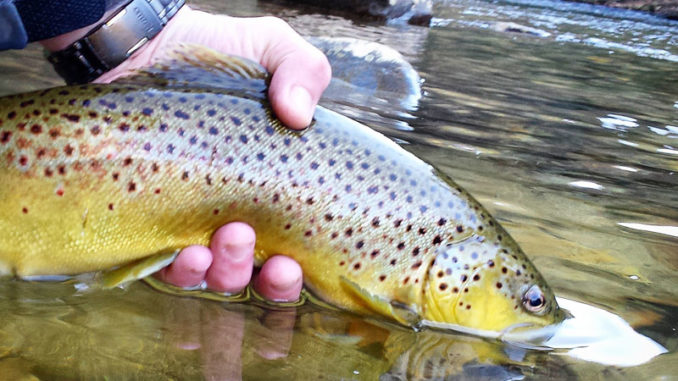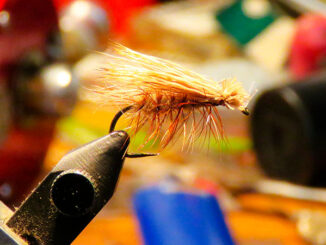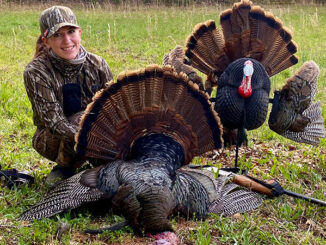
Conditions may be tough, but trout don’t completely shut down
Winter is a time of stark beauty in the mountains, a time when the dominant colors are blue, gray, brown and black. It’s when streams run full and clear and icy cold. And it’s when a warm, sunny day is an event and a blessing for a trout fisher.
Spring is undoubtedly the ideal trout-fishing season. But winter fishing does have its merits. What most fishers discover is that they catch fewer but larger fish. The downside, particularly during the bitterly cold months of January and February, is that the fishing can test an angler’s mettle and patience. The key to successful winter fishing is to use more nymphs and fewer dry flies
With fewer hatches coming off, nymphs are the type of food that trout, particularly large trout, see and prefer. When a big nymph floats past a trout, all he sees is one big mouthful of protein.
The late Mike Terrell of Sylva, N.C., a guide and lifelong trout fisher, once said he liked winter trout fishing, “because streams are less crowded, and you aren’t bothered by bugs. Only the hearty get out in cold weather, and the bigger fish are more active.
“Some of the biggest trout I’ve caught were during a snowstorm,” Terrell said. “January and February are absolutely the best times to catch trophy fish.”
Deep and slow
When nymph-fishing, Terrell kept his nymphs close to the bottom of a pool or run and fished at a slower pace.
“You have to remember that everything slows down in the winter,” he said. “Strikes will be more subtle, sometimes little more than a slight hesitation of the line.”
One of Terrell’s technique was to work upstream and let a nymph dead-drift to the bottom, then stripping the fly in short spurts.
“If you see a trout following the fly but not taking it, freeze,” he said. “If the trout starts to turn away, give the line a jerk. That will make the trout think that the nymph is trying to escape, and he’ll usually strike.”
Terrell used an orange or olive Stimulator as an attractor and a small Winter Midge or Griffith’s Gnat as a dropper when dry-fly fishing.
“The second fly should trail about 12 to 16 inches behind the main fly,” Terrell said, “but you have to be careful not to ‘drown’ the dropper.”
Know the fish
To get results in the winter, fishing techniques must adapt to the weather and to the fish. Trout are less likely to move when the water is 40 degrees or colder, so feeding lanes will be much narrower. The amount of time fishing one spot should be doubled, even tripled. Fish an area thoroughly, move a few feet, and continue casting, using the roll cast to get best results.
Jason Cole, co-owner of Smoky Mountain Fly Fishing in Cherokee, N.C., fishes all winter. He’s caught fish on cold, rainy days, and he’s caught fish when the snow was pouring down.
“It depends on what you can stand,” he said. “The fish will bite regardless.”
Cole avoids nearby park streams in the winter. “It’s tough fishing,” he said. Instead, he fishes the delayed-harvest waters of the Nantahala River in Swain County and the Tuckasegee River in Jackson County. Big waters are more dependable, and these big waters are well-stocked.
Go small
The lower the water temperature, Cole said, the more lethargic the fish. Flies must be placed as close to them as possible. Mostly, Cole said, he fishes with small midges, small caddis flies, Blue Winged-Olives and Woolly Boogers. The midges, he said, do especially well on the delayed-harvest streams.
Leaders usually are 9 feet, or less frequently, 7½ feet, with 6X or 7X tippets. Cole often uses a tandem rig: a No. 18 Blue-Winged-Olive on top and a No. 24 midge tied on an 18-inch tippet as a dropper.
Not all winter fishing is limited to nymphs, however. Warm, sunny winter days can produce small but productive hatches of midges and periodically, Blue-Winged Olives, which can be found on mountain streams almost any time of the year.
For winter dry-fly fishing, patterns should be small: nothing larger than a No. 20 or No. 18.
Whatever the weather brings, one thing is certain. Trout streams will be waiting. The fishing will be good as always — depending on your own definition of good. Trout must eat regardless of the weather. And true trout fishers must fish regardless of the weather.





Be the first to comment